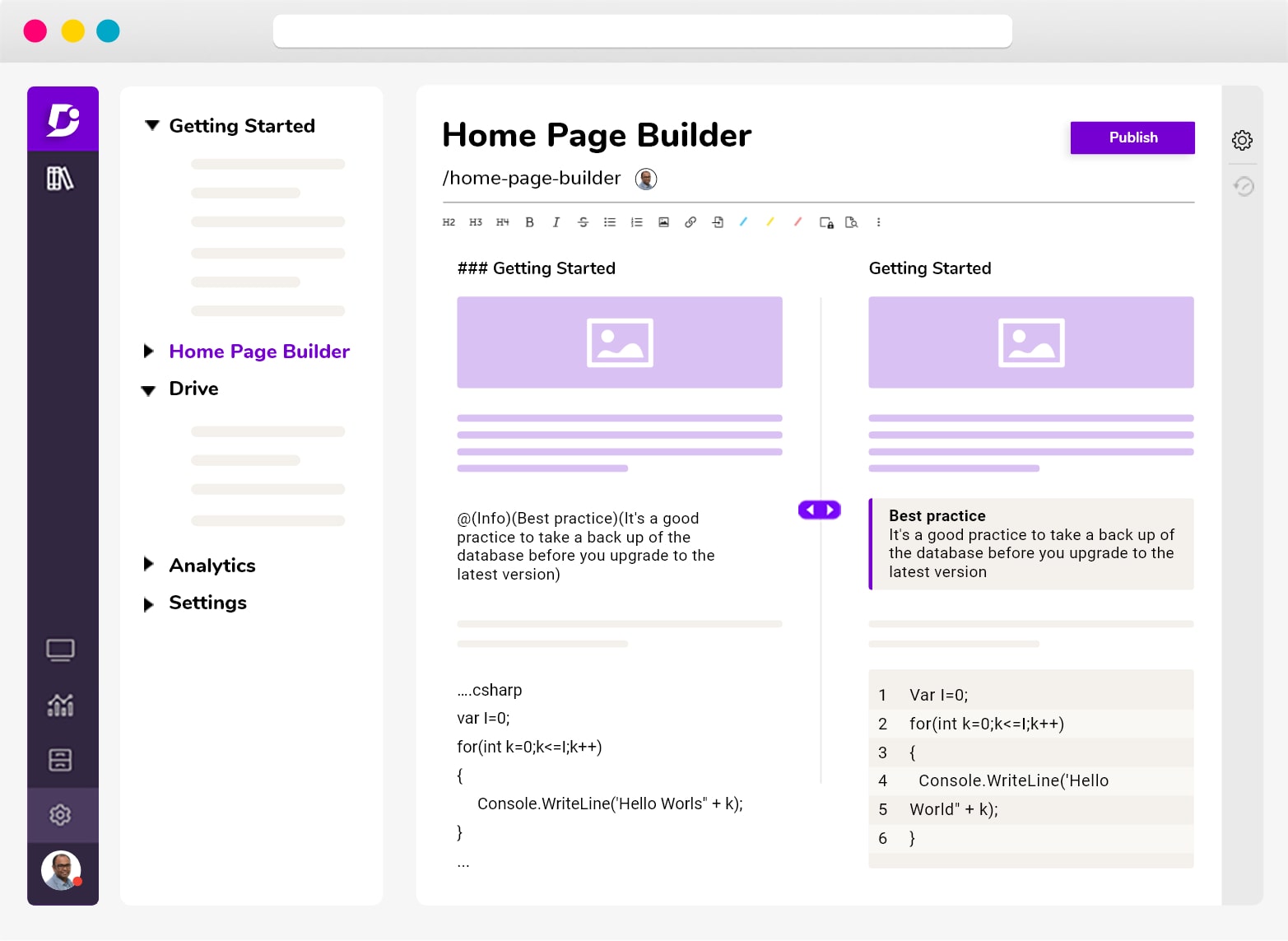The best businesses make it their primary strategy to offer outstanding and delightful customer support. Customers are so impressed and this improves customer satisfaction and loyalty.
But what about those repetitive customer support questions that your team is constantly fielding? Or what happens when your team is so busy that customers are waiting forever to get an answer to a simple query?
You may have guessed that this is where a self-service knowledge base comes in. You can automate away those common customer questions and provide your customers with helpful, instant service in the form of help content.
This article explains how to create a knowledge base to serve your company’s needs.
What Is a Knowledge Base?
A knowledge base is an online documentation repository containing answers to frequently asked questions, troubleshooting guides, how-to instructions, and product information.
Your knowledge base is a one-stop shop for customers to consult when they run into problems and prevents them from having to ask for help from your support team. We’ve come up with a list of the top 10 SaaS knowledge-base examples for you to learn from.
A knowledge base is more than FAQs – it usually comes with a search bar, menu navigation, and multiple content categories.
Knowledge bases are typically built with dedicated knowledge base software that contains all the features you need to publish a user-friendly, accessible knowledge base website.
For example, our knowledge base software Document360 provides a feature-rich solution that allows you to get started on publishing documentation within minutes.
Why is a Knowledge Base Important?
You might be wondering why you should invest your resources into creating an online knowledge base. Well, we’ve got several reasons for you.
Improve Employee Productivity
According to a McKinsey report, employees spend 1.8 hours every day searching for information. This has a serious effect on productivity. Having an internal Knowledge base helps employees to access and look for information quickly.
Also, with the increase in a hybrid environment, it becomes compulsory for the employees to connect with the centralized Knowledge base to outperform their tasks.
Relieves the burden on customer support
A knowledge base allows you to automate away most repetitive customer service queries and frees up the time your support agents have to focus on the more complex cases. With a knowledge base in play, you will need to hire fewer support reps and you can do more with fewer resources.
Enhances customer satisfaction with self-service
Most customers want to help themselves without reaching out to a member of your support team. If a customer has questions about your service or product, an interaction that could have taken ten seconds now takes ten minutes after they have to contact support.
Customers will be more satisfied and increasingly loyal if you offer them the option of self-service.
Improves the onboarding process for new employees
When you bring new employees into your organization, you have a ready-made resource for them to consult while learning about your company and its operations. If new hires have questions they can check the knowledge base and get up to speed more quickly.
Provides 24/7 customer support
Unlike your customer support team, your knowledge base never sleeps. No matter what time zone your customers are in, a self-service knowledge base can provide customer support at all hours of the day, reducing the time customers have to wait for a member of your team to become available. A knowledge base makes your business truly global.
Makes your employees happier
When repetitive queries are automated away, your employees’ overall morale is boosted since they can spend more time on meaningful tasks.
Bear in mind that building a knowledge base isn’t supposed to be a replacement for human interaction – the knowledge base is there to support your team while giving customers ready access to the information they’re looking for.
Help customers help themselves instantly with a Knowledge Base!
Book a Demo
How To Create a Knowledge Base?
- Identify the Purpose/Need of your Knowledge Base
- Define the Core Elements Of Your Knowledge Base
- Prepare Your Knowledge Base Structure
- Prepare Content for Your Knowledge Base
- Organize Knowledge Base Content
- Write New Articles for Your Knowledge Base
- Optimize Your Knowledge Base For SEO
- Publish Your Knowledge Base
- Gather Feedback and Improve
Setting up a knowledge base doesn’t have to be complicated. You need to follow a few simple steps when building a knowledge base, and you’ll be on your way to providing real value for your customers.
1. Identify the Purpose/Need of your Knowledge Base
First of all, determine exactly why you need a knowledge base. Is it for customers or employees? Do you want to help customers get up to speed with your products and services, provide in-depth tutorials, or answer frequently asked questions from potential prospects? Perhaps it’s a mixture of all these things.
When you’ve decided who your audience is for your knowledge base, identify the current gaps in knowledge that exist that create a need for the knowledge base.
- What questions or topics do customers ask about the most?
- Is your support team often overwhelmed with requests for information?
- How long does it currently take your support team to respond to requests and is that response rate getting longer?
- Are there particular members of your team with knowledge that would leave gaps if those employees left the company?
2. Define the Core Elements Of Your Knowledge Base
If you invest in proper knowledge base software, like Document360, it’s likely to come pre-packaged with the core elements included. You don’t need to spend time designing a knowledge base from scratch because the software already comes with ready-made templates for you to take advantage of. All you’ll need to do is set up the knowledge base and start adding content.
Here is a list of core elements that every knowledge base should include.
FAQ Section
The first place customers will look when they have a basic question about your product or service is the FAQ section. This should be a list of commonly asked questions presented in alphabetical order.
Search Bar
Sometimes customers arrive at your knowledge base with a topic already in mind. A search bar makes it easy for customers to search for the specific thing they’re looking for. It should predict what customers are typing and come up with a list of results.
Contact Support
Even if you create the best knowledge base in the world, sometimes customers can’t find what they’re looking for or they’ll still need more help. Including a quick link to contact customer support should be a core element of your knowledge base.
The core elements you need to include in your knowledge base company will be different for every company. You might want to add a “most read articles” widget on your homepage to expose customers to popular content. You might want a “related articles” widget at the bottom of every article, alongside a form to gather feedback. You might want to add a live chat app to your knowledge base so customers can get in touch with your team.
It’s totally up to you how you set up your knowledge base – just do it with the customer at the front of your mind.
3. Prepare Your Knowledge Base Structure
A knowledge base is not only about collecting and storing information, you need to care for the usability. Preparing a knowledge base structure will help you organize the content and allow the user to easily crawl and navigate through the articles. There are many different innovative ways to organize your knowledge base structure. The common and highly successful type is to structure depending on the audience your knowledge base is to cater to.
For example, if you are creating an internal knowledge base you can build it depending on the audience
- Organizational knowledge base
- New employee onboarding
- Human Resources
- Marketing
- Sales
- Customer Support
- Product
- Design
- Engineering
Speaking of the customer when building your knowledge base, next you need to think about your customer service knowledge base structure. It’s no good throwing together articles in an untidy mess because that will make finding information like looking for a needle in a haystack.
Create the structure of your knowledge base with your user at the forefront. You are likely to want to come up with categories for your knowledge base that contain individual articles. Your categories can be organized by product type, by certain user actions, or any number of ways you can think of.
You might want to organize your categories by user roles: beginner, advanced, expert. You can structure it by the stage your user is at in their journey, for example Getting Started, Upgrading Account and Product Tutorials.
4. Prepare Content for Your Knowledge Base
When you’ve organized the structure of your knowledge base, you then need to think about the sort of topics you want to cover and start gathering information.
One of the easiest ways to start coming up with topic ideas is to check your customer support queue for the most commonly asked questions. Take note of any saved replies that your support agents regularly send out to customers and use these as ideas for your knowledge base.
Talk to your support agents about the topics they would like to see covered by the documentation. While you’re at it, converse with your sales and marketing team for topics that get asked by prospective customers.
Make a list of all the topics you want to cover in a spreadsheet and take note of any subject matter experts who need to be involved in the creation of content. Record content that you have already and what gaps you have that need to be filled.
5. Organize Knowledge Base Content
When you have all of your content prepared, you then need to go about organizing the content into categories. We’ve already talked about the structure of your knowledge base but this is about getting down to the article level and assigning a category to each piece of content.
During this step, it’s a good idea to create subcategories to further refine your navigation. In Document360, you can have up to 6 levels of categories for your content. We advise against having too many levels or your knowledge base will become overly complex and customers will find it difficult to browse for information.
6. Write New Articles for Your Knowledge Base
Now it comes down to actually writing your knowledge-base articles! This is the fun part. But remember, writing documentation isn’t like writing a blog post or a novel – it should be informative, straight to the point, and easy to skim.
Title Structure
When writing your knowledge base article, think about the title. People tend to search using very obvious terms and they won’t be likely to use your company jargon when searching for a product feature. Use action words like “How to…” or “Using…”
Remember to make your article titles simple and match the words that customers are using to talk about your products.
Content Tone
As we mentioned earlier, knowledge base articles should be written in a particular way. The language you use should be straightforward, assuming the reader has no prior knowledge about your topic.
Paragraphs
Your paragraphs should be short, with no more than two or three sentences per paragraph. Readers should be able to skim your knowledge base to find the information that’s relevant to them.
Links
Instead of repeatedly explaining the same thing over and over, link to related articles from the body of your content so users can find out more if they want to.
Highlighting using bold and italics
Highlight important parts of your texts using bold and italics. You can use call-outs to draw attention to the important parts of your content and make sure it catches your customer’s eye.
Bullet points and lists
Use bullet points and lists to format sequences of steps in your content. This makes your steps easier to follow and adds variety to your documentation.
Adding Visuals
No one wants to read a wall of text. Think of including images and informative videos to accompany the written portion of your documentation.
Proofread
It may sound obvious, but make sure to proofread your knowledge base articles before setting them to live. Ideally, get a second pair of eyes to edit your article.
7. Optimize Your Knowledge Base For SEO
We’ve told you how to make a knowledge base, so now it’s time to make sure that your knowledge base can be found “externally” through search engines like Google. You want your knowledge base to be found by customers who are browsing for information on the web.
When your knowledge base is indexed by search engines this can even attract new customers to your business. Your knowledge base may well be the first time they encounter your brand so this is your chance to make a good impression.
Make sure your article URLs contain the keyword for your knowledge base article. Include the keyword in your meta descriptions as well.
Most knowledge-based software comes with SEO settings that you can adjust to suit your needs. If you don’t want your knowledge base to be accessible to the public then you can turn off indexing by search engines.
Also Read: Super SEO Tactics to Optimize Your Knowledge Base for Search
8. Publish Your Knowledge Base
The time has come to publish your knowledge base. You’re going to send it out into the world to start helping your customers – but first things first.

Domain/Subdomain
Decide if your knowledge base is going to have its domain or be a subdomain or folder of your main website. If it’s going to be a subdomain, it might be something like help.mycompany.com. If it’s going to be a folder, you might choose mycompany.com/help.
Integrations
If you choose the right knowledge base software then you can integrate with lots of popular applications like help desk tools, live chat, and analytics. You can greatly expand the capabilities of your knowledge base by integrating it into your workflows so users can create documentation on the fly.
User Access Levels
You’ll need to decide who has access to your documentation in the back end. You might give some of your team members editing rights, while some might be restricted to read- or write-only. If you take advantage of user access levels then your knowledge base will be protected from unauthorized edits.
When you’ve taken care of all these things then you are ready to make your knowledge base live. Hit that publish button and sit back and wait – not really! A knowledge base is never done.
9. Gather Feedback and Improve
Once you’ve made your knowledge base live you’re going to want to start collecting feedback on your content. Knowledge-based software should come with in-built analytics that tell you how your content is performing and give indications for improvements.
You can analyze how many searches are receiving no results and use these as ideas for creating new content for your knowledge base.
Articles that receive a significant number of thumbs-down ratings can be rewritten and improved.
Make sure to respond to any customer comments you get on your knowledge base and take steps to improve your articles based on their recommendations.
Best Practices and Tips To Create A Knowledge Base
Now you know how to create your knowledge base website, we’ve got some best practices and tips to help you on your journey.
- Learn from others. Don’t be shy about researching the knowledge bases of other companies and incorporating what you learn into your own site.
- Gather customer feedback. It’s the only way you are going to learn and improve.
- Audit your content. Set regular dates to audit the content of your knowledge base, adding new content and removing articles you don’t need anymore.
- Take care when designing your knowledge base. Remember the User Experience when it comes to accessing your knowledge base and make sure it is accessible.
- Choose the right knowledge base software. We can strongly recommend our own Document360 as a good fit for your company.
- Enlist your customer support team. Who better to do than write articles that will help your customers?
- Make it easy to contact support. Your knowledge base is not a wall preventing customers from talking to a human.
Final Remarks
There you have it – exactly how to create a knowledge base that will save time for your support team and help your customers solve their problems.
It’s all-important to take the time to plan your knowledge base properly before you get down to the nitty-gritty of actually writing articles. Also, spend time researching exactly what hurdles customers are facing so you can use your findings as inspiration for creating content.
If you don’t use dedicated knowledge base software then you’re likely to end up with little more than an FAQ page. You need to invest in a proper knowledge base solution to provide the useful resources that your customers so desperately need.
We suggest our own Document360 platform which is a knowledge base solution right out of the box. You can get up and running fast with our simple and intuitive software and start helping customers right away.
An intuitive knowledge base software to easily add your content and integrate it with any application. Give Document360 a try!
Get Started




 –
– 

